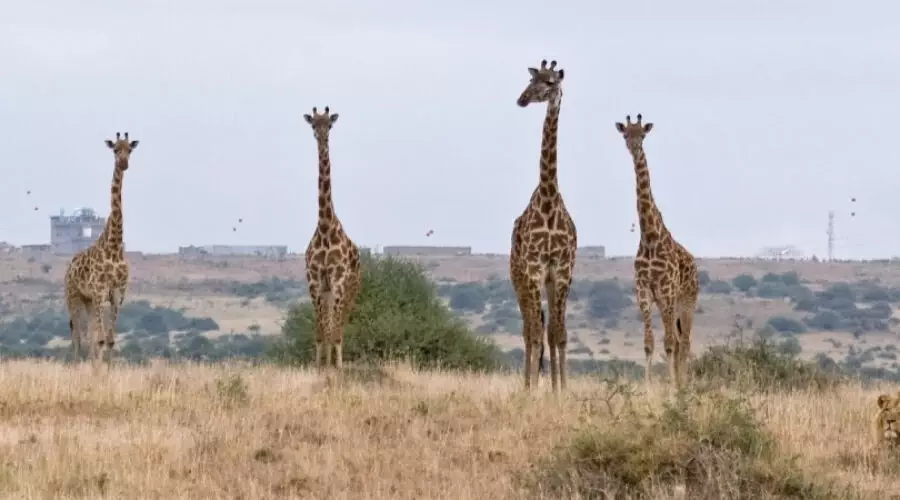Nairobi National Park, History, Entry Fees, and When To Visit
Nairobi National Park.
Just a hop, skip, and a jump from Nairobi’s hustle and bustle, you’ll stumble upon Nairobi National Park. Imagine wide-open grass plains, a cityscape backdrop, and acacia bushes playing host to the wildest party in town – with VIP guests like the endangered black rhino, lion rockstars, leopard fashionistas, cheetah speedsters, hyena comedians, buffalo party crashers, and giraffe high-flyers. It’s like a wildlife gala with over 400 bird species strutting their feathers.
The Wild History of Nairobi National Park
Once upon a savannah…
Back in the late 1800s, the British colonists rolled into what’s now Nairobi, probably thinking, “Nice plains, let’s build a city here!” At the time, the area was full of wildlife—zebras, gazelles, lions, and probably more hooves than shoes. The Athi plains were the animals’ turf, and the Maasai, ever stylish in red shukas, grazed their cattle right alongside the wildlife like it was a daily block party.
Meanwhile, the Kikuyu were farming up in the highlands, and Nairobi was just a baby town—by 1910, it had a population of 14,000 and a lion problem serious enough that people carried guns at night. Imagine going out for milk and needing a rifle.
As the city grew, so did human-wildlife beef. The animals got pushed west and south, and the colonial government—perhaps realizing that lions and laundry don’t mix—turned part of the area into a game reserve. Fancy settlers like Isak Dinesen (a.k.a. the “Out of Africa” lady) would ride their horses among zebras and impala like it was a scene from a royal safari.
Then along came Mervyn Cowie, born in Nairobi and back from a 9-year break in 1932. Instead of nostalgia, he found cows where kudu used to be. Devastated by the decline in wildlife, he said, “Nope, not on my watch!” and campaigned to save what was left.
Back then, the place was still called the Southern Game Reserve. And while hunting was a no-go, other questionable activities like cattle grazing, garbage dumping, and yes—bombing practice by the Royal Air Force (because why not?)—were all fair game. Cowie pushed hard for a proper national park system, and finally, the government said, “Okay fine, let’s do this.”
In 1946, Nairobi National Park officially became the first national park in Kenya!
(Which also means it’s old enough to tell stories that start with “Back in my day…”)
Sadly, the Maasai pastoralists were removed from their ancestral lands in the process—a decision that remains a hot topic in conservation history.
Cowie was appointed the park’s director and ruled the wilderness until 1966 like the lion king of paperwork. One of the most dramatic moments came in 1989, when President Daniel arap Moi set fire to 12 tons of ivory right inside the park. It was a mic-drop moment that screamed: “Kenya is done with poaching!”
Fast-forward to March 5, 2024: A tragic twist occurred when a small Cessna 172 aircraft collided mid-air with a Safarilink Dash 8 and crashed into the park, claiming two lives aboard the Cessna. The skies above even Nairobi’s wild side can be unpredictable.
Nairobi National Park Stats:
-
Size: 117 sq. Km
Climate:
-
January-March: Hot and dry
-
April-June: Hot and wet
-
July-October: Very warm and wet
Best Time to Visit:
-
All year round (because the animal kingdom never takes a vacation)
What to Pack:
-
Hydration station: Drinking water is a must
-
Picnic essentials: Because even lions appreciate a good snack
-
Extras: Binoculars for that front-row view, camera for wildlife selfies, a hat for that movie-star vibe, sunscreen to protect your delicate human skin, sunglasses for the cool factor, and a guidebook because, well, it’s a jungle out there.
Nairobi National Park Star Attractions:
-
Wildlife Extravaganza: Buffalos, giraffes, lions, leopards, baboons, zebras, wildebeests, cheetahs – the A-list of the animal kingdom (100 mammal species strong)
-
Bird Watching Bonanza: 400 bird species showing off their feathered flair
Bonus Features:
-
Picnic Paradise: Ideal for corporate shindigs, bush dinners, wildlife weddings, picnics, team-building (because teamwork makes the dream work), and even the backdrop for video and film productions.
Welcome to Nairobi National Park – Where the Wild Roars Just 7km from Town
Nairobi National Park, Entry Fees (Because even wildlife has bills to pay)
Kenyan Citizens & Residents:
Adults: Ksh 430 (Cheaper than a pizza)
Children: Ksh 215 (Bring the little ones – they’re cheap!)
Non-Residents (a.k.a. Our Honored Guests):
Adults: USD 43 (That’s a wild deal)
Children: USD 22 (Small humans, smaller fees)
How to Pay (Sorry, no goats accepted): All payments go through eCitizen using M-Pesa, Visa, RTGS, or EFT. No cash, no confusion, no monkey business.
Need a Guide?
Ksh 1,720 for up to 4 hours (perfect for quick safari flings)
Ksh 3,015 for over 4 hours (for the serious animal stalkers)
VIP Van Hire
Ksh 10,000 for up to 2.5 hours. (Arrive like royalty, leave like a wildlife whisperer.)
Vehicle Charges: From Ksh 300 to Ksh 5,000 depending on how many seats your ride’s packing—from tiny tuk-tuks to 45-seaters full of safari squad goals.
Must-Visit Spots in the Park:
Impala Point – for the chill vibes
Ivory Burning Site – history with a hot twist
Kingfisher Picnic Site – perfect for romantic bites or noisy family feasts
Mokoyiet – because why not?
Activities Galore:
Game viewing (obviously)
Picnics and bush dinners
Bird watching for the chirp-curious
Team building and events (yes, even your HR department will love it)
Nairobi National Park Game Drive Options:
Self-drive (for the brave)
Hire a VIP van (for the boujee)
Shuttle buses (available during Easter & Christmas)
Nairobi National Park Contacts
Need to Talk to the Real Wildlife Experts?
Phone: (020) 2618763 / (020) 2379407
Email: nnp@kws.go.ke




